Operation: Duisberg
Date: 14th October 1944 (Saturday)
Unit: No. 625 Squadron
Type: Lancaster I
Serial: LL956
Code: CF-Q
Base: RAF Kelsterrn
Location: Between Fotherby and Little Grimsby
Pilot: P/O. Lloyd Albert Hannah J/87007 RCAF Age 26. Killed (1)
Pilot 2: Sgt. D.R. Paige R/174406 RCAF Safe
Fl/Eng: Sgt. R.B. Bennett 3050216 RAFVR Safe
Nav: Fl/Sgt. K. Roy Strachan R/160305 RCAF Safe
Air/Bmr: Fl/Sgt. Lloyd Douglas Bennett R/188356 RCAF Age 26. Killed
W/Op/Air/Gnr: Fl/Sgt. J. Bilan R/172682 RCAF Safe
Air/Gnr: Sgt. K.J. McCrorie R/265605 RCAF Safe
Air/Gnr: Fl/Sgt. Jack H. Loughran R/217337 RCAF Safe
Page researched by David Langner and compiled by Jack Albrecht with Nic Lewis for Aircrew Remembered
REASON FOR LOSS:
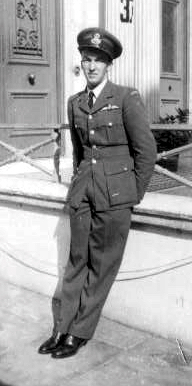
On the 03rd August 1944 P/O. L.H. Hannah and his crew arrived at RAF Kelstern from 11 Base. They included Sgt. G. Maynard, flight engineer, Sgt. T.M. Baird, air bomber, Fl/Sgt. K.R. Strachan, navigator, Sgt. J. Soule, wireless operator, Sgt. G.E. Way, mid upper gunner, and Sgt. J.H. Loughran, rear gunner.
Left: F/O. Lloyd Albert Hannah
After adjusting to squadron life and training flights to assess their fitness for ops they participated on their first mission to Raimbert on the 31st August 1944. For the next eight trips they gelled as a team to French targets and one to Frankfurt. Their ninth sortie to Frederick Hendrick was abortive and all bombs were brought back to Base.
By the time of his tenth op P/O. Hannah was considered sufficiently battle hardened to take a rookie pilot and his crew on a ‘second dickie’ trip on a maximum effort show to Duisburg. For this raid P/O. Hannah would depend on his navigator, Fl/Sgt. Strachan and rear gunner, Fl/Sgt. Loughran to keep him on track and the night fighters off his tail. For Sgt. Paige and his crew this would be a most memorable and insightful op. The rest of the crew as shown above - a crew of eight.
31 aircraft were detailed to attack the target, but one of the aircraft - “Q” , Captain and Pilot, P/O. Hannah and the Bomb Aimer, Fl/Sgt. Bennett - crashed just after take off and both of them were killed, the remaining six members baling out safely. From wheels up to impact - just 6 minutes! A period of great anxiety all of this time resting on the shoulders of the pilot to make the right decisions. The 30 remaining aircraft went on and bombed the target fairly accurately in spite of intense flak.
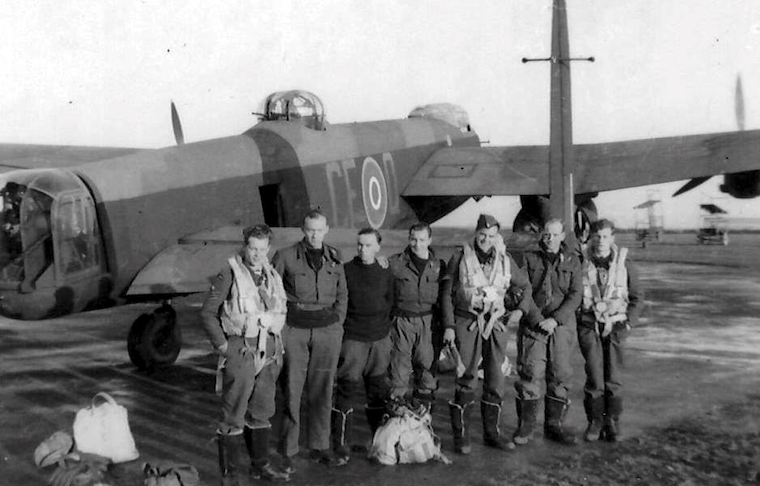

Information provided by F/O. Hannah’s nephew, David Langner, adds to the tragedy of this loss. This includes accounts of the events from the rear gunner, Fl/Sgt. Loughran and F/O. Hannah’s brother, Harold, who was also lost on operations at a later date.
Harold related that LL956 had been grounded the previous week due to higher than normal operating temperature in the engine that caught on fire and that as a result of the Duisburg raid being a maximum effort the allowable temperature for this aircraft to participate was increased to include LL956 on the Battle Order.
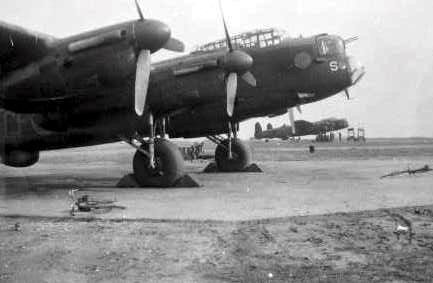
Lancasters at dispersal RAF Kelstern
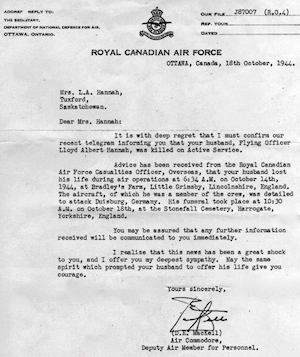
27/10/44
"Dear Mrs. Hannah (Lloyd’s widow)
I was the rear gunner in Lloyd’s crew and was with him the morning of the fateful accident. I think it best that I should tell you some of the facts of the crash, so that you will understand, as do we, what a hero Lloyd was.
We were taking off on our thirteenth trip, to Duisburg, when the starboard inner engine caught fire. It was only due to expert skill and with the help of God’s hand that he even got her off the ground. The fire got out of control and the skipper ordered us to abandon ship. There was no panic and we were out of the aircraft in a matter of seconds but even at that there wasn’t a chance for Lloyd. The aircraft blew up and crashed to the ground.
There was just the navigator and myself of Lloyd’s crew on board and the rest of the positions were being manned by another crew on their first operational sortie. The rest of the crew thought the world of Lloyd, and for myself, I lost the best friend a fellow could have in the Air Force.
I met Harold and Gladys at the funeral but as yet have not had time to have a long talk. They gave Lloyd an all Canadian funeral. There were lots of flowers, and I managed to take a few pictures of the grave which I will send as soon as they are developed.
I have found it very hard to write this and I am deeply sorry that I can’t do more than offer my most heartfelt sympathies and to remember you and Lloyd in my prayers.
I will say good-night for now and may God bless you.
Yours Sincerely, J. Loughran"
19/10/44
"Dear Mother, I’ve been trying for hours to think what I should put in the letter, but I don’t suppose I would ever say the right thing.
By this time you’ll know that Lloyd was killed on the 14th, so I’ll try and give some of the details.
He was taking off on a raid at six o’clock on Saturday morning, and when he was about ready to lift the Lancaster off the runway one of the motors caught fire, he did the only thing he could have done and got off the ground and immediately tried to put the fire out. This proved impossible and so he climbed as best he could on three engines, and he managed to get to about 800 feet and he told his crew to bale out, and he held the airplane level, but before he could get out himself one of the gas tanks blew up, and the airplane went straight into the ground, and all the bombs exploded and blew a hole in the ground about sixty feet across. He wasn’t excited at all, and by his coolness, and by quick thinking he saved the lives of six men. The seventh got out but didn’t get his parachute to open.
I didn’t know anything about it and went on leave to visit him on Monday morning. After getting the details I went to Harrogate where he was buried on Wednesday morning, October 18th, at 11 a.m.
Gladys and I, Bert Ormson and Elmer Hannah were there. It’s a beautiful cemetery, and is being fixed up by the Canadian government. The air force took some photos and there were some private ones taken, and I’ll see that you get them right away.
At present I am in London finishing my leave with Gladys.Please don’t feel too badly Mother, if he had to die he died one of the best deaths a man could, and by his sacrifice and by doing practically the impossible, he saved the lives of six men. My one ambition is to be half the man he was.
Love, Harold". (Lloyd’s younger brother)
An eyewitness account by an air raid warden describes how the pilot manoeuvred his crippled Lancaster to avoid hitting the villages of Fotherby or Little Grimsby. LL956 crashed in a field midway between the two. The impact and secondary explosion from the fuel and bomb load blew the windows out of nearby farm and greenhouses, and scattered debris. It is incredible that no civilian lives were lost and symbolic that the crash site is still marked by a pond that is visible on Google Earth. Out of respect the farmer has not filled it in and it has been a habitat for carp and a rogue pike.
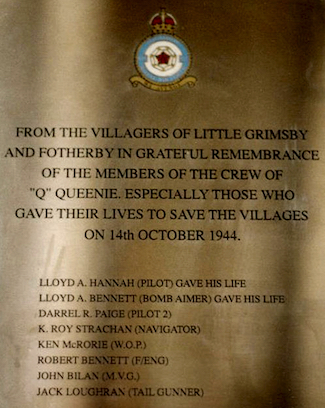
This tragic event would have a lasting impression on their squadron mates participating in this Duisburg raid - the first of two that day! LL956 was tenth in the take off sequence, starting her take off roll at 06:28, 17 minutes after Sq/Ldr. Hamilton in LM691 lifted off to join the bomber stream. During the ground run, past the point of no return P/O. Hannah was confronted with every bomber pilot’s nightmare - an engine fire, at maximum gross take off weight of fuel and bombs, and facing rising terrain. The crews already departed were quite likely ignorant of his plight unless observed by vigilant gunners. The three crews that took off next would have had a ringside seat as the tragedy unfolded. The twenty crews taxying around the airfield perimeter to position for take off had no choice but to watch as their unknown squadron mates struggled with a futile situation, as parachutes blossomed and LL956 was consumed by a terrific explosion. Amongst the captive spectators was F/O. David Mattingley and his crew, awaiting the green flare from flight control to get the show on the road. In his book, Battle Order 204, he recounts how their crew was mesmerised by the vision of a Lancaster crippled by an engine alight, struggling to return to Base, the relief of five parachutes, followed by a terrific explosion. This indelible vision was imprinted for life. Who would be next?
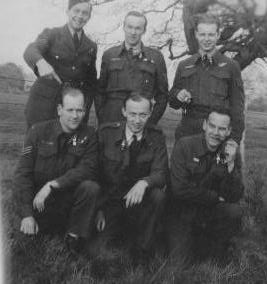
It is difficult to explain the death of the air bomber, Fl/Sgt. Bennett. His position as a member of the crew would make him responsible for removing the forward escape hatch to facilitate the bale out for the forward six members of the crew. The rear entry door would be the escape route for the two gunners. Fl/Sgt. Bennett should have been the first to leave through the nose hatch. If so his parachute failed to deploy due to faulty packing or his inability to pull the rip cord. However, there is another explanation that is just as plausible. After releasing the hatch, he assisted the other members in their escape and then stuck his head into the cockpit just to the right of P/O. Hannah’s feet and asked if he could help his pilot. It is noteworthy that they shared nationality, age and christian names. Fighting to control a mortally wounded bomber with his life unravelling before his eyes it is quite likely that he exhorted: ”Lloyd, GO NOW!” We will never know but by now the altitude for a safe bale out was lost in their slipstream.
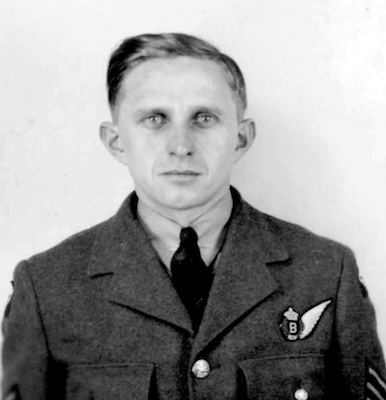
Left: Fl/Sgt. Lloyd Douglas Bennett.
The Burial Return for R/188356 Fl/Sgt. Bennett at the Harrogate, Yorkshire Stonefall Cemetery states Means of I.D: By features and signet ring. There was no burial return completed for P/O. L.A. Hannah.
P/O. Hannah was married. His widow would not remarry until in her eighties. It took her that long to find a man who could fill Lloyd’s shoes. Fl/Sgt. Bennett was a graduate pharmacist. He would never put his education to use. Their headstone inscriptions are most fitting.
(1) On the 27th January 1945 Lloyd Hannah would be joined by his younger brother, Harold, several rows back. The Second World War was a very costly and devastating affair for Allan and Mary Hannah of Moose Jaw, Saskatchewan, Canada.
His brother, F/O. Harold Allan Hannah died from injuries received on the 03rd November 1944. Flying with 405 Squadron Lancaster III PB413 LQ-K on return from an operation to Dusseldorf.
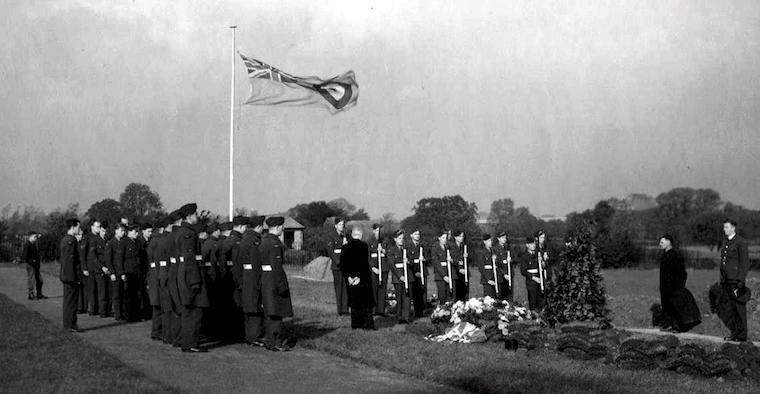
Above: Funeral of F/O. Lloyd Albert Hannah - 18th October 1944.
Burial details:F/O. Lloyd Albert Hannah. Harrogate Cemetery (Stonefall). Sec. G. Row A. Grave 11. Son of Allan and Mary Hannah, of Moose Jaw, Saskatchewan, Canada and husband of Margaret Lorene Hannah, of Tuxford, Saskatchewan, Canada. Grave inscription reads: "Greater Love Hath No Man Than This: He Gave His Life That We Might Live".
Fl/Sgt. Lloyd Douglas Bennett. Harrogate Cemetery (Stonefall). Sec. G. Row A. Grave 12. Son of Frank and Sadie Bennett, of Aylmer, Ontario, Canada. Grave inscription reads: "Greater Love Hath No Man Than This".
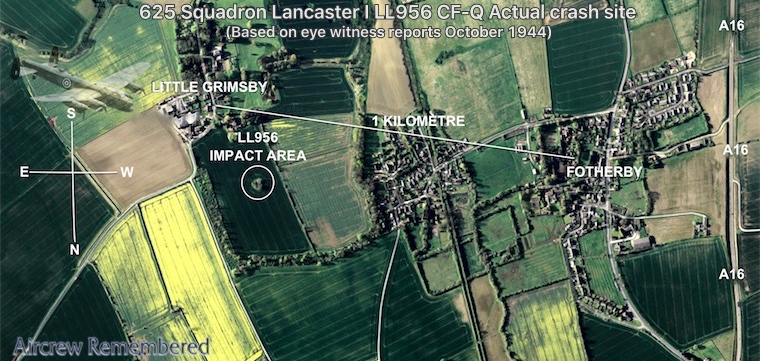
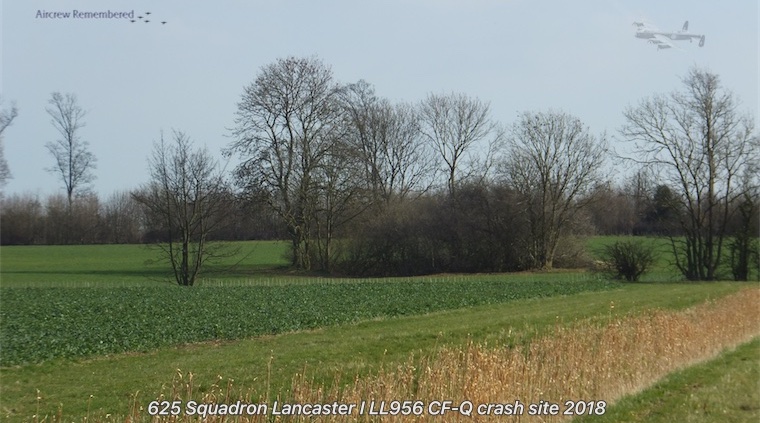
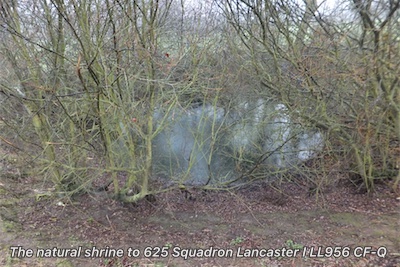
Above and left: Crash site of LL956 seventy years after the event- a natural shrine preserved in memory of the violent deaths of the aircrew of Bomber Command. Of the seventy-four Lancasters and crews lost by 625 Squadron, fifty-five met violent traumatic ends or were lost without a trace. Of these less than a handful crashed to earth in England.
This explains why the citizens of Occupied European countries have great compassion and memorialise these brave brave young men. There is no reason to suspect that the aircrew of the other Squadrons of Bomber Command would have experienced different outcomes. It is quite likely that the Squadrons operating with Wellingtons, Stirlings and Halifaxes would have suffered even higher losses.
David Langner and Sally Bishop have provided the photographs of crew, burial and commemorative plaque as well as input to localise the Google Earth crash site and crash site photos. The photograph of F/S Bennett courtesy of Library and Archives Canada/Ancestry.ca - 625 Squadron Aircrew and Graveside Photos and Documents- F/S Lloyd Douglas Bennett, R188356, p.93 RG24 24839/ May 2017.
Decoration suggestions submitted by Jack Albrecht:
P/O. L.A. Hannah - Victoria Cross for gallantry “in the presence of the enemy”, eye witness accounts by crew, Squadron mates and citizens of Fotherby and Little Grimsby.* Fl/Sgt. D.B. Bennett - Conspicuous Gallantry Medal for an act or acts of conspicuous gallantry during active operations against the enemy, eye witness accounts by crew, Squadron mates and citizens of Fotherby and Little Grimsby. (It should be noted that P/O. Hannah was promoted to F/O. posthumously) *- notable VC exceptions: G/C Leonard Cheshire and P/O Andrew Mynarski.
For 2nd Pilot D.R. Paige, Sgt's. R.B. Bennett and McRorie this would be an invaluable dress rehearsal for the 23rd February 1945 raid on Pforzheim, Loss # 66 - PB815. This loss was due to friendly fire, struck by incendiaries from above. The wireless operator, Fl/Sgt. J. Bettany, a member of the RAFVR, was awarded the CGM for his actions in extinguishing numerous fuselage fires. However, when a wing fire threatened an adjacent fuel tank the crew was forced to bale out. They all survived, the only injury being a sprained ankle by the navigator. There is no doubt that the spirit of P/O. Lloyd Hannah was with them as they floated to earth. For three members of this crew this adventure would make them Honorary Members of the Caterpillar Club - extremely rare for Bomber Command aircrew with most of them getting one kick at the cat to become PoWs or evaders in Occupied Europe. P/O. Paige was prudent to fly westward to reach the friendly side of the battle line. They would be soon back to Base and in their warm beds. The exception was the navigator in a hospital bed nursing a sick ankle.